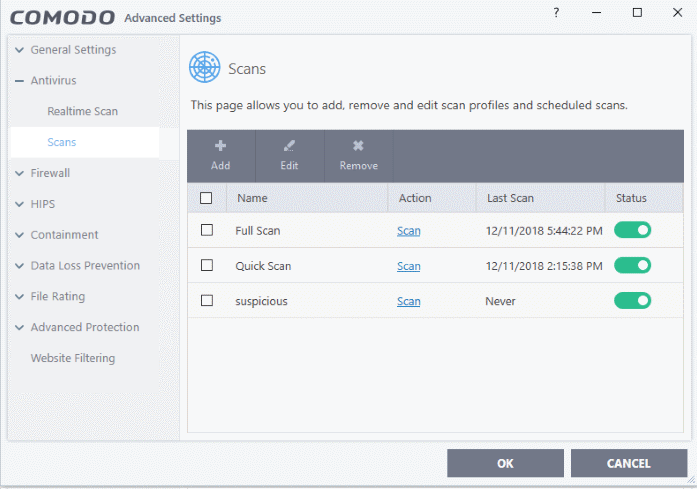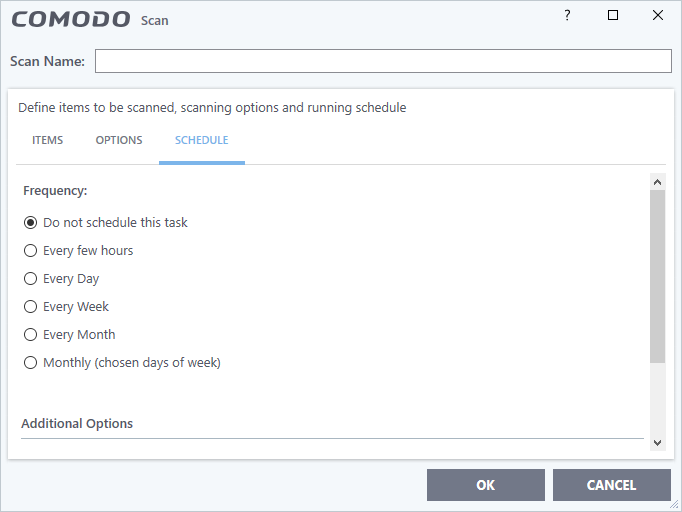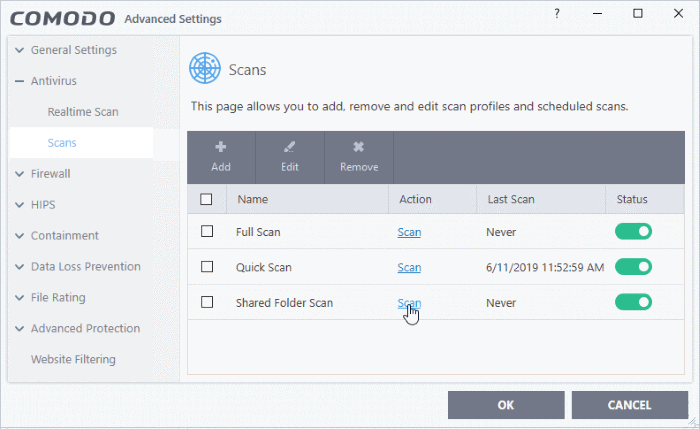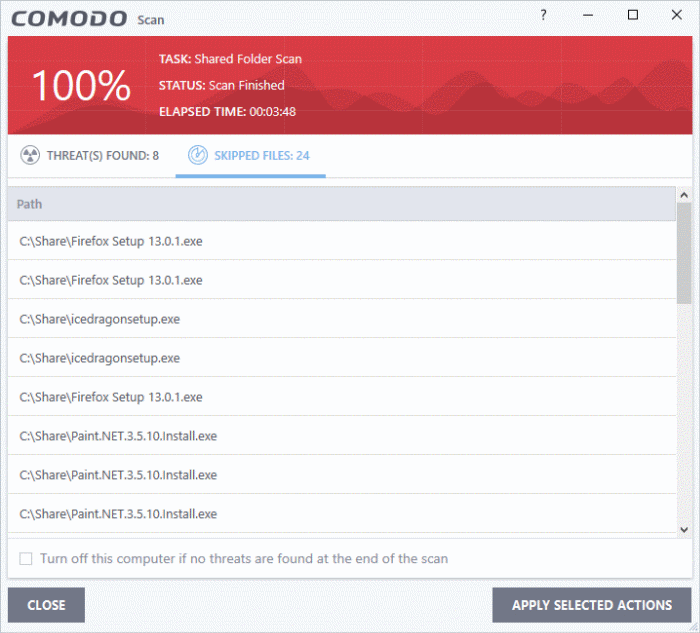Scan Profiles
- Click 'Settings' > 'Antivirus' > 'Scans'
An antivirus scan profile is a collection of scanner settings that tell CCS:
- What to scan (which files, folders or drives)
- When to scan (you can create a scan schedule)
- How
to scan (you can configure the behavior of the
scan engine)
CCS ships with two pre-defined scan profiles and allows you to create custom scan profiles.
- Full Scan - Scans every file, folder and drive on your system. External devices such as USB sticks and storage drives are also scanned if connected.
- Quick Scan - Scans critical areas of your computer which are highly prone to infection and attack. Areas scanned include system memory, auto-run entries, hidden services, boot sectors, important registry keys, and system files. These areas are of great importance to the health of your computer, so it is essential to keep them clean.
You cannot modify the areas scanned in a pre-defined profile, but you can edit the scan parameters. You can also create custom profiles and scan schedules.
Open the 'Scans' panel
- Click 'Settings' on the CCS home screen
- Click 'Antivirus' > 'Scans'

|
Scan Profiles - Column Descriptions |
|
|---|---|
|
Column Header |
Description |
|
Name |
Name of the scan profile. |
|
Action |
The activity that the profile is set to perform. Click this link to manually run a scan according to the profile's parameters. |
|
Last Scan |
Date and time of the most recent virus scan using this profile. |
|
Status |
Enable or disable the
profile. 'On' – Any scheduled scans configured in the profile will continue to run. In addition, you can manually run the scan at any time by clicking the 'Scan' link. 'Off' - Any scheduled scans configured in the profile will not run.You can still manually run the scan by clicking the 'Scan' link. |
The following sections explain more
on:
- Click 'Settings' on the top of the CCS home screen
- Click 'Antivirus' > 'Scans'
- Click 'Add' from the options at the top.
The profile configuration screen opens:

- Type
a name for the profile
The next steps are to:
- Click 'Items' at the top of the 'Scan' interface.
The buttons along the top let you add three types of item to the scan. You can add any combination of items.
- Add Files - Scan individual files. Click the 'Add Files' button and navigate to the file you want to scan. Repeat to add more files.
- Add Folder - Scan entire folders. The scan covers all files inside the target folders. Click the 'Add Folder' button and choose the folder you want to scan.
- Add Area - Scan pre-defined regions. Regions include 'Full Computer', 'Commonly Infected Areas' and 'Memory'.

- Repeat the process to add more items to the profile. You can mix-and-match files, folders and areas in your custom scan.
- Click 'Options' at the top of the scan interface
- Decompress and scan compressed files - The scan will include archive files such as .ZIP and .RAR files. Supported formats include RAR, WinRAR, ZIP, WinZIP ARJ, WinARJ and CAB archives. (Default = Enabled).
- Use cloud while scanning - Improves scan accuracy by augmenting the local scan with an online look-up of Comodo's latest signature database. Cloud Scanning means CCS can detect the latest malware even if your virus database is out-dated. (Default = Disabled)
- Automatically clean threats - Whether or not CCS should automatically remove any malware found by the scan.
- Disabled = Results are shown at the end of the scan with a list of any identified threats. You can select the action to be taken on them individually, or on all items at-once. See Process Infected Files for guidance on manually handling detected threats.
- Enabled = You can choose the automatic action taken against detected threats. The options are:
- Quarantine Threats - Infected items will be moved to Quarantine. You can review quarantined items later and remove them or restore them (in case of false positives). See Manage Quarantined Items for more details on managing quarantined items.
- Disinfect Threats - If a disinfection routine is available, the antivirus will remove the infection and keep the original, safe, file. If not, the item is moved to 'Quarantine'. (Default)
- Show scan result window - If selected, you will see a summary of results at the end of the scan. This includes the number of objects scanned and the number of threats found.
- Use heuristics scanning - Enable or disable heuristic scans, and define the sensitivity of the scanner. (Default = Enabled)
Background. Heuristics is a technology that analyzes a file to see if it contains code typical of a virus. It is about detecting 'virus-like' attributes rather than looking for a signature which exactly matches a signature on the blacklist. This allows CCS to detect brand new viruses even that are not in the current virus database.If enabled, please select a sensitivity level. The sensitivity level determines how likely it is that heuristics will decide a file is malware:
- Low - Least likely to decide that an unknown file is malware. Generates the fewest alerts.
Despite the name, this setting combines a very high level of protection with a low rate of false positives. Comodo recommends this setting for most users. (Default)
- Medium - Detects unknown threats with greater sensitivity than the low setting, but with a corresponding rise in possible false positives.
- High - Highest sensitivity to detecting unknown threats. This also raises the possibility of more alerts and false positives.
- Limit maximum file size to - Specify the largest file size that the antivirus should scan. CCS will not scan files bigger than the size specified here. (Default = 40 MB)
- Limit maximum script size to - Shows the largest file size that the antivirus should scan. If a script is larger than the size specified here CCS will not scan . (Default = 8 MB)
- Run this scan with - Whether you want to set a priority for the scans with this profile
- Enabled = You can set the priority. The available options are:
- High
- Normal
- Low
- Background
- Disabled = The scan will be run at the background (Default)
- Update virus database before running - CCS checks for and downloads the latest virus signatures before starting every scan with this profile. (Default = Enabled)
- Detect potentially unwanted applications - The antivirus also scans for applications that (i) a user may or may not be aware is installed on their computer, or (ii) may contain functionality and objectives that are not clear to the user. Example PUA's include adware and browser toolbars. PUA's are often bundled as an additional utility when installing another piece of software. Unlike malware, many PUA's are legitimate pieces of software with their own EULA agreements. However, the true functionality of the utility might not have been made clear to the end-user at the time of installation. For example, a browser toolbar that tells you the weather forecast might also track your online activity. (Default = Enabled)
- Apply this action to suspicious autorun processes - Specify how CCS should handle unrecognized auto-run items, Windows services and scheduled tasks.
- Ignore - The item is allowed to run (Default)
- Terminate - CCS stops the process / service
- Terminate and Disable - Auto-run processes will be stopped and the corresponding auto-run entry removed. In the case of a service, CCS disables the service.
- Quarantine and Disable - Auto-run processes will be quarantined and the corresponding auto-run entry removed. In the case of a service, CCS disables the service.
Note 1 - This setting monitors only registry records during the on-demand scan. To monitor the registry at all times, go to 'Advanced Settings' > 'Advanced Protection' > 'Miscellaneous'.
- See Miscellaneous Settings for more details.
Note 2 - CCS ships with a list of applications for which script analysis will be performed to protect the registry records. You can manage the list of applications in 'Advanced Settings' > 'Advanced Protection' > 'Script Analysis' > 'Autorun Scans'
- See 'Autorun Scans' in 'Script Analysis Settings' fro more details.
- Limit scan time of a single file to - Set the maximum time allowed to scan an individual file. CCS will skip files that take longer to scan than the specified time. Omitted files are shown in the 'Skipped Files' tab in the results screen.
Schedule the scan
- Click 'Schedule' at the top of the 'Scan' interface.

You have the following options:
- Do not schedule this task - The scan profile will be created but will not run automatically. The profile will be available for on-demand scans.
- Every few hours - Run the scan at the intervals of the hours specified in 'Repeat scan every NN hour(s)'.
- Every Day - Run the scan every day at the time specified in the 'Start Time' field.
- Every Week - Run the scan on the day(s) specified in 'Days of the Week', at the time specified in the 'Start Time' field. You can select the days of the week by clicking on them.
- Every Month - Run the scan on the date(s) specified in 'Days of the month', at the time specified in the 'Start Time' field. You can select the dates of the month by clicking on them.
- Monthly (chosen days of the week) – Run the scan on specific weeks in a month. Select the target weeks in the menus provided.
Additional Options
- Run only when computer is not running on battery - The scan only runs when the computer is plugged into the power supply. This option is useful when you are using a laptop or other mobile device.
- Run only when computer is IDLE - The scan will run only if the computer is in idle state at the scheduled time. Select this option if you do not want the scan to disturb you while you are using your computer.
- Turn off computer if no threats are found at the end of the scan - Will turn off your computer if no threats are found during the scan. This is useful when you are scheduling scans to run at nights.
- Run during Windows Automatic Maintenance - Only available for Windows 8 and later. Select this option if you want the scan to run when Windows enters into automatic maintenance mode. The scan will run at maintenance time in addition to the configured schedule.
The option 'Run during Windows Maintenance' will be available only if 'Automatically Clean Threats' is enabled for the scan profile under the 'Options' tab. See Automatically Clean Threats.
|
Note: Scheduled scans will only run if the profile is enabled. Use the switch in the 'Status' column to turn the profile on or off. |
- Click 'OK' to save the profile.
The profile will be available for deployment in future.
Run a custom scan as per a scan profile
- Click 'General Tasks' on the CCS home screen
- Click 'Scan' > 'Custom Scan'
- Click 'More Scan Options'
- Click 'Scan' beside the required scan profile.

The scan will start immediately. Results are displayed afterwards:

The results window has two tabs:
- Threats Found: The number of files scanned and the number of viruses found.
- Use the drop-down to choose whether to clean, quarantine or ignore the threat.
- See 'Process infected files' if you need help with these options.
|
Note: You will only see the drop-down menus if 'Automatically clean threats' is disabled for the selected scan profile in 'Settings' > 'Antivirus' > 'Scans'. See Scan Profiles for help with this. |
- Skipped Files: Files that were not checked for viruses. The scanner skipped these files as they took longer than the scan time limit (default = 9 mins).




